Date of publication: 09/28/2018
Tooth filing has been used in dentistry since the 19th century. At that time, the procedure helped treat caries by mechanically removing damaged tissue. Today the technique is used to eliminate other problems, mainly aesthetic ones.
For example, teeth can be filed if one or more units stand out from the general row due to their increased length. Filing can also help with small chips on the edges of the tooth.
In what cases is tooth filing used?
There are different opinions about the advisability of the procedure. It is mainly carried out in the following cases:
- When the upper incisors or canines stand out too much. This not only disrupts aesthetics, but can also interfere with proper bite. In this state of affairs, the teeth can be shortened a little so that they fit better into the dentition.
- If there are small chips on the edges of the teeth. A slight grinding of the enamel will help smooth out the edge.
- If there are sharp corners. Sometimes, due to anatomical features, the front teeth may have protruding parts. They may not look aesthetically pleasing or even damage the cheek.
- For orthodontic bite correction. Sometimes teeth are filed down on the sides to make it easier to move them into the correct position. This is important when installing braces if your teeth are very crowded.
- Filing down the front of the teeth is used when installing veneers. The teeth are also ground down before crowns are installed.
The advisability of filing is determined individually only at the appointment of a specialist.
At home
Fear of doctors and thoughts about the pain of professional manipulations often lead to patients trying to cope with the existing problem on their own. Teeth filing is also no exception.
Dentists share their experience that people often come to appointments whose enamel has been severely damaged by attempts to cut off part of it with various improvised tools in the desire to improve the aesthetic appearance of the jaw row with prominent front teeth or the presence of chips.
In addition to the problem of high sensitivity, these patients experience cracks in the hard tissue, as well as dentin damage, which develops as a result of bacteria entering the dentinal tubules through open pores.
The consequence of such independent actions can be the development of caries, pulpitis and numerous complications that can lead to partial or complete tooth destruction.
Dentists categorically prohibit performing teeth filing procedures at home. Only a specialist can determine the need for an operation to remove a section of enamel and carry it out efficiently, without the risk of complications.
Expert opinion
Roman Borisovich Alekperov
orthopedic dentist
Experience: 24 years
If there are indications for filing teeth, it is important to entrust this procedure to an experienced dentist who will correct the aesthetic defect and not cause harm to the teeth. Self-filing is impossible and extremely dangerous - you can seriously damage the tooth, and in the future you will have to resort to microprosthetics or crown prosthetics. There is also a high risk of injury to the mucous membrane and infection.
Contraindications
The necessity and admissibility of filing teeth is determined by the dentist individually in each case, since the procedure is quite labor-intensive and can be traumatic in some situations.
For this reason, sewing hard fabric is contraindicated in the following situations:
- increased abrasion of enamel;
- hyperesthesia;
- bruxism;
- presence of bad habits - frequent chewing of seeds and nuts, opening bottles with teeth;
- high risk of injury to the incisors, for example, boxing and other types of wrestling.
How is filing done?
The technology varies depending on the purpose for which the procedure is performed. The process includes a number of steps:
- - Diagnostics. The doctor determines which teeth will be filed and for what purpose. To do this, a visual inspection is carried out, the cause is studied, and the method of performing the procedure is determined.
- — The area in which manipulation is necessary is determined. For this, carbon paper, wax plates, and special aerosols can be used. This helps to highlight or color an area that, for example, prevents the jaws from closing properly. In difficult cases, a plaster model of the jaw can be made.
- If the procedure requires significant removal of hard tissue, anesthesia is performed.
- Sawing is done using a diamond bur. On chewing teeth, a small layer of enamel on the protruding tubercles can be filed away. If we are talking about incisors, the movements are multidirectional and depend on the situation.
- After the procedure, the surface that was manipulated is polished. Also, remineralizing substances can be applied to the surface of the teeth, as well as compositions to strengthen the surface and reduce sensitivity.
When filing teeth, the thickness of the enamel in the treated areas changes. This may cause increased sensitivity. Usually this is a temporary phenomenon and in the first days it is necessary to refrain from eating hot and cold foods so as not to provoke discomfort and pain. If the problem does not go away over time, you should consult a doctor.
Cases in which you can straighten teeth without braces
The braces system is the most effective, fastest and painless method for straightening crooked teeth, but many people refuse it for many reasons: they are embarrassed, afraid of discomfort or discomfort associated with eating or while talking.
But there are cases when a person can correct his bite without braces:
- Crooked teeth are only a couple of teeth, not an entire row, so there is no need to wear a complex system;
- The bite only slightly deviates from the norm, but if the bite is open, then braces are still necessary;
- A slight crooked tooth needs to be quickly corrected;
- A person with a “dental” problem is allergic to the metal components that are in braces;
- The gums are located too low, and there is a high probability of injuring them due to the locks of the brace system;
- The patient cannot or does not want to adhere to the rules of wearing and caring for braces;
- The patient wants to look perfect at work or in everyday life, so the use of braces in this case is excluded;
- The patient’s work involves clear and excellent diction (radio DJ, TV presenter, teacher), so he must refuse to wear braces.
Possible consequences
Most patients who have undergone filing note increased sensitivity of the treated teeth. The effect is enhanced by consuming very cold or hot foods, as well as foods with a hard texture.
The thing is that the dentin, located under the enamel, has a large accumulation of small channels, inside of which there are nerve endings. When the top layer is removed, they open, which increases the sensitivity of the teeth and may cause pain.
In order to reduce the sensitivity of the filed jaw row, experts advise giving up the following for a while after the event:
- Extremely cold and hot foods.
- Solid products.
- Sour and carbonated drinks.
Oral hygiene procedures should be carried out using a soft toothbrush and a specialized medicated toothpaste or dental rinse that helps reduce sensitivity.
If symptoms do not disappear more than 10 days after the filing procedure, you should contact your dentist for help.
When preparation for veneers is not necessary
Composite veneering is a method in which a composite layer is applied to the tooth, layer by layer, each time drying it with light. This allows the dentist to adjust the thickness of the veneer, shape the cutting edge and shape. Thanks to layer-by-layer application, the tooth does not need to be turned, the surface is simply ground. In all other cases, the enamel is ground to different depths.
There is another type of overlay that does not require turning - these are lumineers. They are made from special material, only in the USA. You have to wait for delivery, and if 1 lumineer breaks, then you also have to wait until it is made and sent. The Russian analogue, ultranirs, does not need to wait long, but if you need to correct the shape of a tooth, you will still have to grind it down.
Thin veneers can correct only minor defects: lighten teeth a couple of tones, cover dim pigmentation, mask the gap between teeth.
This method has disadvantages:
- Even ultra-thin veneers without grinding enlarge teeth
. With small teeth this is not noticeable, but if the teeth are large, then they visually look too massive. - to correct the shape of a tooth without grinding.
- It is difficult
to smooth the transition of the veneer to the gum ; bacteria can accumulate there, causing caries.
Features of the event
Before grinding teeth, X-ray diagnostics are performed to clarify their structure, identify possible hidden pathologies and determine places where the thickness of the dental tissues is the smallest, which means there is a possibility of opening the pulp chamber during preparation. If the procedure is performed on living teeth, local anesthesia is performed. On previously pulpless teeth, preparation does not require anesthesia, but many patients still ask for it to be done so as not to experience discomfort.
Today, dentists carry out several types of dental tissue preparation, differing in the tools and technology used:
- Tunnel grinding of teeth . It is carried out using a turbine medical unit (bur) with steel or diamond tips of the working tool. This installation makes it possible to regulate the speed of the procedure, and during preparation the doctor tries to remove as little of his own dental tissue as possible. The main advantage of the method is the ability to fully control the depth of preparation and complete predictability of the result obtained.
- Ultrasonic preparation . The procedure is carried out using high-frequency ultrasonic vibration of the working tool. In this case, the dental tissues do not heat up, the pressure on them is minimal, there are no microcracks or chips in the enamel, and the pulp tissues are not affected in any way.
- Laser preparation . The procedure is carried out using a pulsed laser, under the influence of which the desired layer of enamel and dentin is removed. The procedure is completely safe, silent, atraumatic, and completely eliminates the possibility of infection and the formation of chips and cracks.
- Chemical method . The dental tissue is softened using an active chemical (usually acids) and then removed. There is no heating of dental tissues, chips or microcracks.
- Air abrasive method . An air-powder mixture is used here, which is supplied under high pressure. Abrasive particles of powder remove the desired layer of hard tissue, and tooth dust is immediately removed from the oral cavity.
When choosing a technique, the doctor is usually guided by a number of factors: the clinical situation, the condition of the oral cavity as a whole, the wishes of the patient and the capabilities of the clinic.
Treatment methods
Treatment of pathological tooth wear may include therapeutic and orthopedic techniques. In the first case, there are two options:
- Drug therapy (includes the application of gels and solutions, the use of special toothpaste).
- Restoration (special filling material is used).
Orthopedic treatment involves the manufacture and installation of onlays, dentures or crowns, which restore the normal appearance and functionality of teeth.
Currently, dentists do not agree on the timing of initiation and specific treatment methods in different situations. Most often, drug treatment is used in patients in the early stages of the disease, when the teeth are not yet seriously damaged. For more severe pathology, restorative and orthopedic treatment is indicated.
Indications
Among dental specialists, there are opposing views on the procedure for filing teeth. Some consider it harmful to health and impractical, while others, on the contrary, recommend it to their patients as an effective method. However, there are situations when this is necessary.
Installation of crowns
To firmly fix the elements in the oral cavity, they must be tightly adjacent to the teeth. Since the natural shape of molars or incisors is rarely ideal, filing of the superficial hard tissues is necessary. This is what helps the tooth in the future to obtain the desired shape, thanks to which the prepared crown is tightly attached and does not get knocked out among the other units.
Attaching veneers
Ceramic plates, which are fixed on the surface of natural teeth, are significantly thick. In order to install them firmly and align with existing elements, a small amount of enamel is removed from the vestibular part of the jaw row.
Preparation for inlays
If it is necessary to hide cavities caused by caries, dental specialists can use ceramic or metal inlays. To secure them to the tooth, they require side walls and a certain depth near the cavity.
Installation of orthodontic structure
Grinding down the top layer of teeth helps create space for adjusting the position of other row units without having to remove them. This option is also suitable if the teeth are too close to each other. The procedure makes it easier to install braces.
Damage to tooth enamel
Chips on the incisors can be hidden by slightly sawing off the top cover. This will add aesthetics to your smile and eliminate the need for restoration.
Elongated incisors
When the front teeth are longer than the other units in the oral cavity, this not only brings psychological discomfort to the person, but can also create problems with diction. It also interferes with the main function of teeth – chewing food. In this case, alignment of the protruding parts is essential.
Sharp corners
The anatomical shape of a tooth is rarely ideal. Sharp corners are most often recommended for filing to create a neat appearance of the oral cavity.
As a result, pathological abrasion of teeth occurs
The pathogenesis of the disease involves several factors, both external and internal.
| Endogenous factors | Exogenous factors |
| Metabolic disease. Gastrointestinal diseases. Pathology of the endocrine system. Bruxism (teeth grinding). | Patient's nutrition. Nature of working conditions. Incorrect prosthetics. |
The greatest influence on the abrasion process itself is exerted by occlusal forces, which have the following characteristics:
- The amount of chewing force. It is determined by the strength of the masticatory muscles, which can range from 80 to 400 kg. It is necessary to take into account that teeth are under stress not only when chewing food, but also when swallowing, and a person performs several thousand swallowing movements per day.
- Duration. During the day, the occlusal surfaces of the teeth come into contact with each other for half an hour, but with pathology, this figure can increase significantly.
- Application point and direction. The occlusal force is directed at right angles to the chewing surface of the tooth. Normally, the contact area is several square millimeters, but with pathology it can increase several tens of times, which leads to greater efforts when chewing.
In the presence of harmful production factors, bruxism, fluorosis and other reasons mentioned above, all characteristics of occlusal forces change for the worse, which leads to tooth abrasion.
Veneers and teeth grinding are the main problems
Veneers are thin plates of ceramic or reflective composite materials used to correct the shape or color of teeth. Microprostheses have many advantages - high aesthetics, durability and reliability. But at the same time, the overlays have a significant drawback, which often becomes a reason for patients to refuse the procedure. We are talking about such an important stage as preparing the tooth before installing veneers.
Interesting fact!
Veneers were first invented in America in the 30s of the twentieth century. At first they were made to order for Hollywood stars, so that they would shine not only with their talents, but also with their perfect, dazzling smiles. However, at that time they were glued to the teeth for only a few days with a special adhesive mixture. Compared to modern orthopedic designs, these were primitive and crude onlays for quick correction of teeth during filming.
Crooked teeth are not a death sentence
With the onset of a certain age, people often come to the understanding that it is time to change something. Including in appearance. Modern plastic surgery can correct any mistakes of nature, erase traces of years and fatigue from the face. It's sad when all your efforts are ruined by an ugly smile.
Along with cosmetic manipulations, bite correction in adults becomes an important step on the path to transformation and gaining self-confidence. A good orthodontist can help straighten teeth for patients of any age.
Types of ledges when fixing crowns
If you look at the photo below, it will immediately be clear what ledges are - they are needed to fix the crowns. Such ledges are located under the gum so that the border between the tooth and the prosthesis is hidden.
Accordingly, they also come in different shapes:
- knife-shaped: in fact, in such a situation there is no ledge - the top of the tooth will simply have the shape of a cone. Solid metal crowns are fixed in this way (but today this method is rarely used),
- rounded: used for attaching metal-ceramic crowns, but also not used often,
- shoulder: this is the most popular option, and it is also universal. Such a ledge, although large in thickness, is considered the most aesthetic. It has an angle of approximately 90 degrees.
How dangerous is crooked teeth in adults?
Now you know what ways there are to correct your bite in adulthood. If you want to transform your appearance, qualified dental orthodontists will help you!
But what happens if bite defects are not corrected? Are crooked teeth so harmless, even if they don't bother you? This is not an idle question, and here's why.
Even if you are not currently concerned about aesthetics, crooked teeth can cause a lot of trouble in the future. First there will be problems with oral hygiene. The accumulation of bacteria and plaque in hard-to-reach interdental spaces will lead to the development of caries, which will be difficult to notice. The process of tissue destruction will deepen, which can lead to pulpitis, the development of an inflammatory process in the roots and, as a result, tooth loss, destruction of bone tissue, impaired diction and facial deformation. And that's not the worst thing. Anomalies of the dental system can cause a number of disorders in the functioning of the masticatory muscles and the temporomandibular joint. As a result, difficulties with chewing food, excessive abrasion of teeth, and disturbances in the gastrointestinal tract. As you can see, crooked teeth can ruin not only a smile, but also affect the health and appearance of an adult.
While some people invent problems for themselves and try to correct even ideal proportions, others do not notice obvious defects and put their health in serious danger.
Don’t put off visiting a qualified orthodontist. A good doctor will assess the actual condition of the patient’s teeth and suggest the most effective way to solve the problems. ←Return to list of articles
Physiology is to blame for everything
To begin with, let's say that all the causes of tooth wear can be divided into two large classes - physiological and pathological.
The first reason appears immediately after the final eruption of baby teeth - and this is a natural process. In children, the incisors, cusps on the canines and molars gradually wear away, and by the age of 6 years, the depth of wear down to the dentin can be observed. In the future, until the age of 14, when the teeth are finally replaced by permanent ones, abrasion of the dentinal layer of the first teeth is sometimes noted. Severe abrasion is diagnosed when the entire upper part of the tooth disappears or the cavity becomes visible.
In general, due to physiological characteristics, teeth adapt to stress during the process of wear. Without dangerous overloads, the work of the entire dental system is adjusted; contacts between teeth change the angle from point to plane, so that the closure of the jaws is more physiological.
If the changes affect only the enamel, there is nothing to worry about. But if dentin begins to participate in the process of abrasion, this is a reason to consult a doctor.
Aligners (aligners)
An aligner is a mouth guard made of silicone or soft plastic that exactly follows the contours of the teeth and works like a brace system, albeit slowly but effectively straightening the teeth. Despite the proven effectiveness of aligners, they are not used so often, mainly to correct bites.
The advantages of this method:
- Almost invisible on the teeth;
- Easy to remove while eating or brushing your teeth;
- Does not cause discomfort;
- There are no restrictions on food when wearing a mouth guard;
- Does not cause pain when wearing;
- You can treat “oral” problems while wearing a mouth guard;
- Do not cause allergies;
- Along with straightening, you can also whiten your teeth;
- Has no contraindications.
Disadvantages of this method:
- Not effective for complex problems;
- High price;
- Before eating, food must be removed prematurely and stored properly;
- Long production time (mouthguards are often delivered from abroad).
In order to comprehensively straighten crooked teeth using a mouth guard, you need to go through several stages. First, the dentist takes impressions of the teeth and creates an electronic model. The same layout is necessary at intermediate stages of treatment, as well as at the end of the procedure. For the entire stage of treatment, you need several drops, which should be changed after 2-3 weeks, as prescribed by the doctor.
The patient should wear the mouth guard at least 22 hours a day and remove it only to eat and brush teeth. The duration of treatment is from 6 to 8 months, and in case of prophylaxis.
What preparation is needed before turning?
In order to secure the future prosthesis well, the prepared crown must be strong, free of plaque and stone, and free of carious lesions (if any, the doctor will, of course, remove them first). Also, before treating the enamel under any prosthesis, it is important to remove soft and hard plaque.
Only until December 25 South Korean implant Osstem - from 18,500 rubles.
Hurry up to sign up for a free consultation and lock in promotional prices.
Call now or request a call
Opening hours: 24 hours a day - seven days a week











